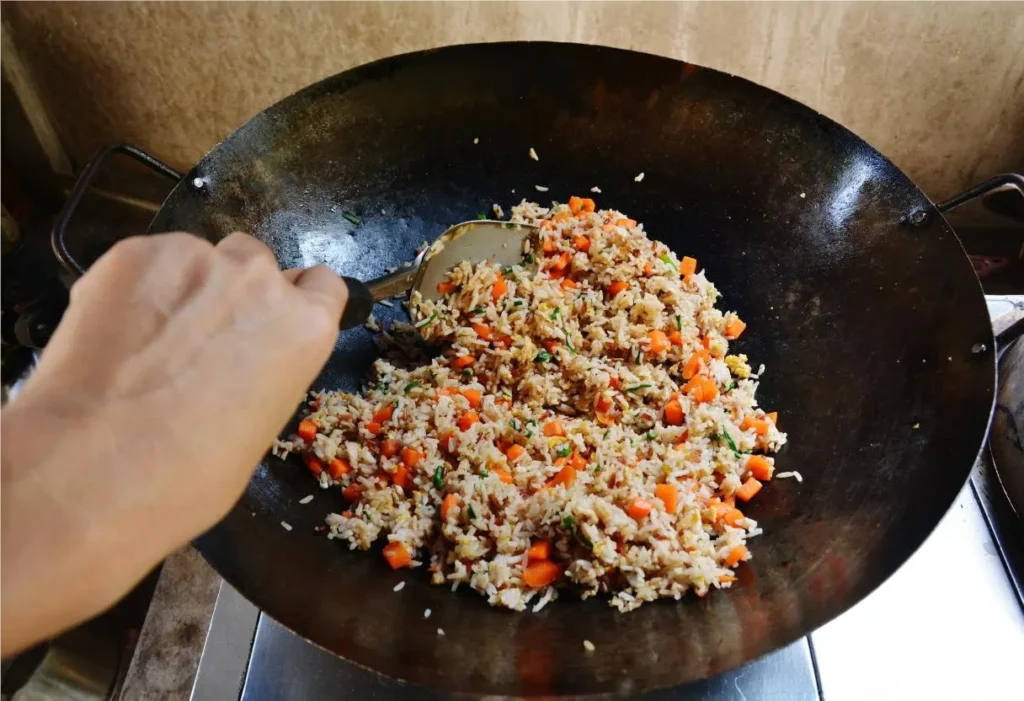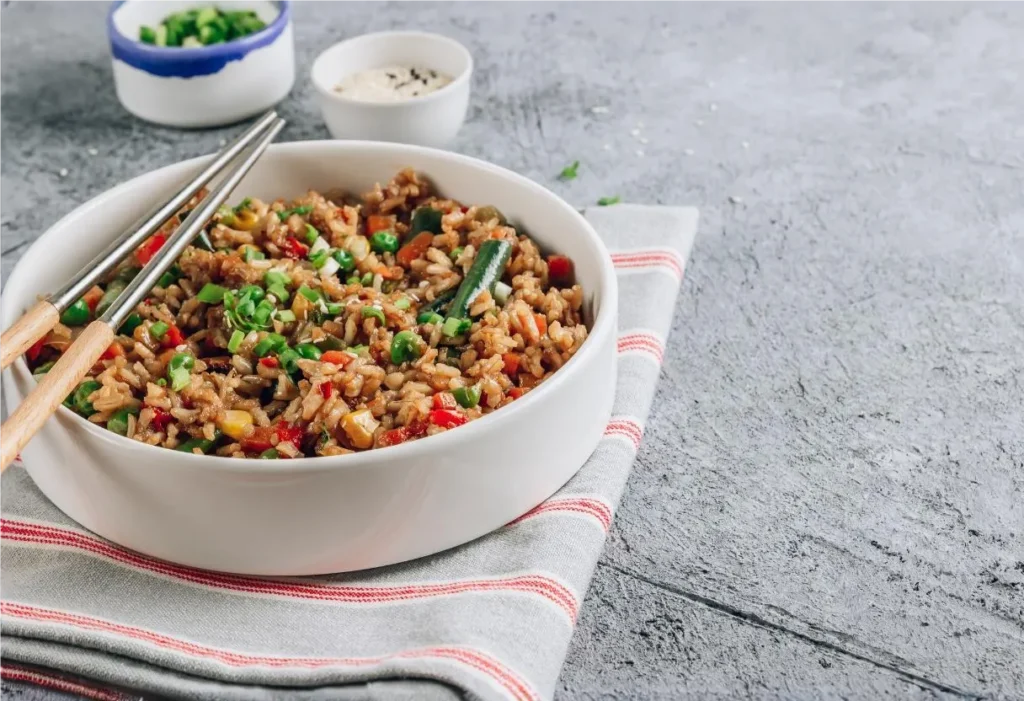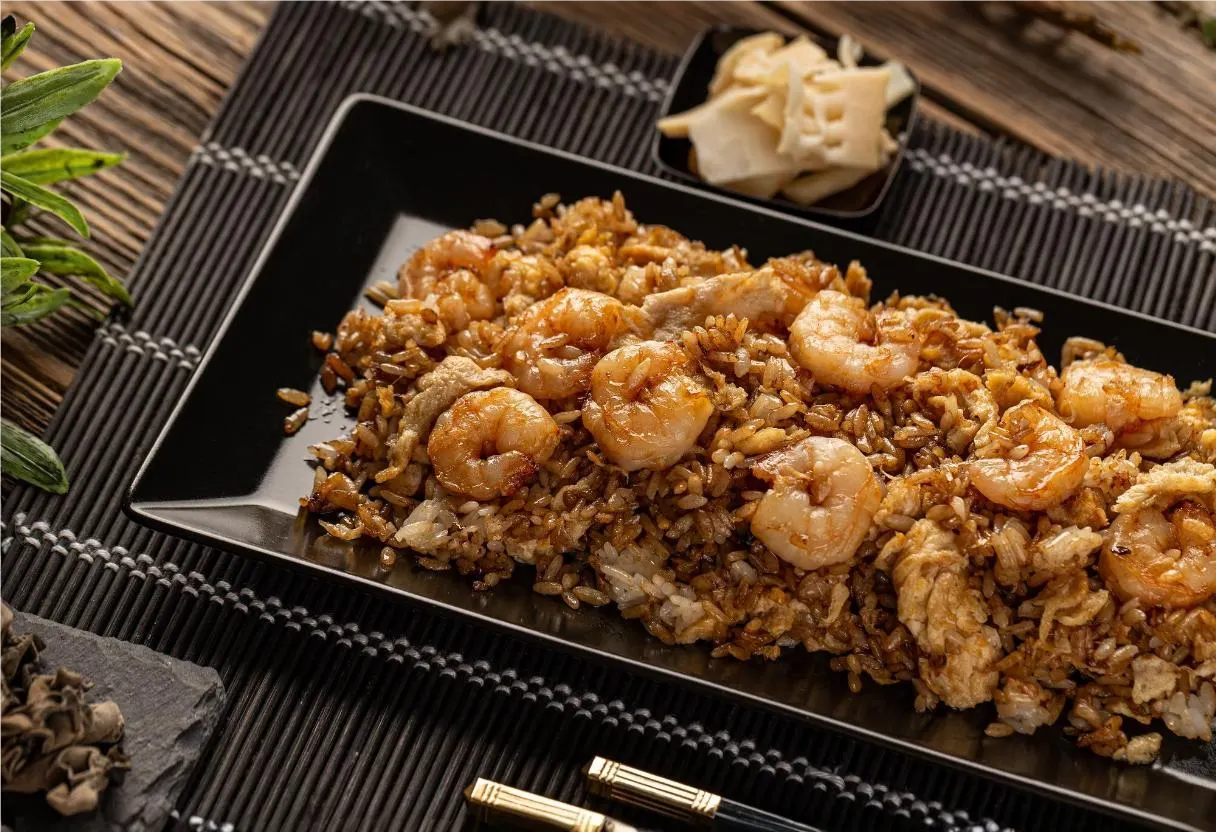Learn how to cook authentic hibachi rice recipe at home. Explore key tips, techniques, and savory variations for an irresistible, restaurant-inspired meal!
Introduction
Hibachi rice is a beloved staple of Japanese-American cuisine, known for its enticing aroma, perfectly seasoned rice, and interactive cooking style. Despite its popularity in hibachi restaurants, making this dish at home is not as difficult as it might seem. In fact, with the right techniques, a few essential ingredients, and some helpful tips, you can recreate the distinct flavors of authentic hibachi rice right in your kitchen. Therefore, this comprehensive guide will walk you through every detail, from choosing the right type of rice to perfecting your stir-fry methods.
In many cases, people associate the word “hibachi” with theatrical dining experiences where chefs showcase dazzling knife tricks and playful banter. However, the term “hibachi” originally referred to a traditional Japanese heating device used for cooking. Over time, hibachi restaurants in the United States popularized a slightly different style known as teppanyaki, which involves grilling and stir-frying ingredients on a large, flat iron plate in front of diners. Because of this, hibachi rice has become synonymous with the dinner show experience. Yet, you can enjoy the same signature flavors without the flashy performance.
In this article, we will explore the origins of hibachi rice, break down the essential ingredients, analyze cooking equipment and techniques, and guide you through a step-by-step recipe. We will also discuss common mistakes and ways to avoid them, plus share enticing flavor variations. Whether you prefer chicken, shrimp, or vegetarian versions, there is a hibachi rice recipe that will surely impress. Finally, we will provide nutritional information and answer frequently asked questions so you can become a true hibachi rice master. Let’s begin!
Table of Contents
Understanding the Origins of Hibachi Rice
The Significance of Hibachi in Japanese Culture
When you hear “hibachi,” you might picture sizzling meals being prepared tableside. Originally, however, hibachi referred to a small, portable heating container often used to grill food indoors in Japan. Although traditional hibachi is different from the large metal cooking surfaces seen in many U.S. restaurants, it laid the foundation for what we now call “hibachi cooking.” This cooking style typically emphasizes simple, fresh ingredients, which are cooked quickly over high heat to enhance natural flavors.
Because hibachi cooking offers a convivial way to enjoy meals, Japanese families sometimes gathered around these grills for warmth and shared dining. Over time, as Japanese cuisine gained global popularity, American restaurants adapted the concept to form lively dining experiences. By combining showmanship, fresh produce, and bold seasoning, hibachi restaurants captured the hearts (and appetites) of U.S. diners.
From Teppanyaki to the U.S. Hibachi Craze
While hibachi remains tied to its heritage, what many Americans call “hibachi” is technically teppanyaki. Teppanyaki involves cooking on a flat-top griddle, allowing chefs to perform dynamic knife tricks and flamboyant fire displays. Because Americans embraced this entertaining dining style, it quickly became popular nationwide.
During this evolution, fried rice made its way onto the teppanyaki grill. Chefs discovered that combining leftover rice with soy sauce, veggies, and protein chunks created a fragrant, satisfying side dish. This adaptation soon became known as “hibachi rice.” Today, the dish is cherished as part of a broader hibachi-style meal, often accompanied by grilled meats, vegetables, and signature sauces.
Essential Ingredients for Authentic Hibachi Rice
Understanding the correct ingredients is the first step to making hibachi rice at home. Each component plays a specific role in achieving the classic balance of flavor, aroma, and texture.
Choosing the Right Rice
One of the most important factors in making an excellent hibachi rice recipe is the rice itself. Typically, medium- or long-grain white rice works best. The grains maintain a slightly firm texture and resist getting too sticky. Additionally, day-old or cold rice is ideal because it helps prevent a mushy consistency when stir-fried. If you must cook the rice fresh, spread it on a baking sheet and let it cool before cooking. This precaution ensures the grains remain separate and more easily absorb seasonings.
Vegetables, Proteins, and Seasonings
Common vegetables for hibachi rice include onions, peas, carrots, and scallions. Feel free to add extras such as mushrooms, bell peppers, or zucchini for variety. Furthermore, you can customize your protein choices with bite-sized chicken pieces, shrimp, steak, or tofu. Many hibachi chefs season proteins with salt, pepper, garlic, and sometimes a splash of soy sauce to enhance taste.
Additionally, seasoning is critical for authentic flavor. Key ingredients often include soy sauce, sesame oil, salt, pepper, and a dash of garlic. Some recipes call for ginger or hot sauce for a little kick. Balanced seasoning is what gives hibachi rice its famous savory taste, so remember to taste and adjust along the way.
Butter and Oils: The Secret to Flavor
If you have ever watched a hibachi chef, you have probably seen them use butter liberally. This butter helps the rice caramelize slightly while adding a creamy richness. However, you will also need a high-temperature cooking oil such as canola or vegetable oil for stir-frying. Sesame oil is usually used in small quantities for an authentic nutty finish. Blending butter and oil is what sets hibachi rice apart from typical fried rice. It also imparts that tempting, lightly toasted aroma we associate with hibachi.
Equipment and Techniques to Perfect Hibachi Rice

While having an authentic hibachi grill is helpful, it is certainly not a requirement for cooking remarkable hibachi rice at home. However, using suitable cookware and mastering certain techniques can ensure your dish achieves restaurant-quality appeal.
A Look at the Hibachi Grill vs. Stove-Top Cooking
Traditional hibachi grills use charcoal or gas to create a consistent, intense heat suitable for stir-frying meats, vegetables, and rice. Yet, most home kitchens do not have a large, flat teppanyaki plate. Therefore, a wide cast-iron skillet or wok can replicate the high heat and generous cooking surface you need. Both options allow you to spread out the ingredients, promoting even browning and reducing clumping.
Mastering Temperature Control
High heat is essential for authentic hibachi rice. However, you must be careful to avoid burning or scorching. Therefore, heat your pan before adding oil. Once the oil is hot but not smoking, add the ingredients in stages. This method ensures each element cooks properly. If you notice the ingredients sizzling too aggressively or beginning to stick, briefly reduce the heat or add a small splash of additional oil. Balance is key: you want a good sear and lightly crisp texture without charring the rice.
Mise en Place: Prepping Like a Chef
Hibachi-style cooking moves quickly, so preparing all your ingredients beforehand is crucial. This approach is known as “mise en place,” meaning “everything in its place.” Chop the vegetables uniformly, measure out seasonings, and have your proteins ready. For proteins like chicken or shrimp, cook them separately and set aside before mixing with rice. This ensures they reach the correct doneness. Once your mise en place is ready, the actual stir-frying process becomes seamless.
Detailed Hibachi Rice Recipe
Below is a complete breakdown of how to make a restaurant-style hibachi rice recipe at home. Remember, the key is to maintain a high cooking temperature and to keep your ingredients moving to prevent sticking or uneven cooking.
Ingredients
- 3 cups cooked medium- or long-grain white rice (preferably day-old, chilled)
- 1 cup mixed vegetables (diced carrots, peas, onions, and any extras like bell peppers)
- 2 tablespoons butter (divided)
- 2 tablespoons cooking oil (such as canola or vegetable oil)
- 1 tablespoon sesame oil
- 2 cloves garlic (minced)
- 2 tablespoons soy sauce (or more, to taste)
- Salt and pepper to taste
- Optional proteins: 1 cup cooked chicken pieces, shrimp, steak strips, or cubed tofu
- Optional garnish: chopped scallions or sesame seeds
Step-by-Step Cooking Instructions
- Prepare Your Rice:
- If you are cooking fresh rice, rinse it once or twice to remove extra starch.
- Cook according to package instructions. Then, spread the rice on a baking sheet or large plate to cool.
- If possible, refrigerate it overnight to firm up the grains.
- Cook Proteins Separately (If Using):
- Season your protein of choice lightly with salt, pepper, and garlic.
- In a hot pan with a tablespoon of oil, sear the protein until browned and fully cooked.
- Remove from heat and set aside.
- Heat the Pan:
- Choose a wok or a wide cast-iron skillet. Place it on medium-high heat.
- Add 1 tablespoon of cooking oil and allow it to heat for about 30 seconds.
- Sauté the Vegetables:
- Toss the onions, carrots, peas, or any chosen vegetables into the pan.
- Stir frequently so they cook evenly.
- If using raw garlic, you can add it now for a robust flavor, or wait to stir it in with the rice to prevent burning.
- Add Butter and Rice:
- Push the vegetables to the edges of the pan.
- Add 1 tablespoon butter to the center. Once it melts, stir in the chilled rice.
- Increase the heat slightly to achieve a nice sizzle. Keep the rice moving to prevent sticking.
- Incorporate Seasonings:
- Drizzle in the sesame oil for a nutty fragrance.
- Add soy sauce gradually, mixing well to coat all the grains.
- Taste and add more soy sauce, salt, or pepper if needed.
- Mix in Proteins and Final Butter:
- Gently fold in the cooked proteins, ensuring they are well-distributed.
- Add the remaining tablespoon of butter, allowing it to melt throughout the rice.
- Keep stirring until everything is hot and lightly browned.
- Garnish and Serve:
- Sprinkle chopped scallions or sesame seeds on top if desired.
- Serve immediately while it’s still hot and flavorful.
By following these steps, you will replicate the taste and texture of restaurant-style hibachi rice. However, feel free to adjust seasonings or add extra veggies to suit your palate. For example, if you like spice, toss in a dash of chili flakes or sriracha.

Nutritional Information (per 100g)
Below is a general nutritional estimate for hibachi rice (without added proteins):
| Nutrient | Amount (per 100g) |
|---|---|
| Calories | ~150 kcal |
| Total Fat | ~4 g |
| Carbohydrates | ~24 g |
| Protein | ~3 g |
| Sodium | ~210 mg |
| Fiber | ~1 g |
| Sugar | <1 g |
| Cholesterol | ~5 mg |
Note: Adding extra protein like chicken, shrimp, or steak will change these values. Also, the exact nutritional breakdown can vary based on the specific ingredients and amounts used.
Flavor Variations and Add-Ons
Hibachi rice is a versatile dish. Therefore, you can transform it by simply switching up the proteins, adjusting the spices, or incorporating more vegetables. Here are a few popular variations to try:
Hibachi Chicken Rice
For a quick weeknight meal, chicken is a go-to option. Season bite-sized chicken pieces with salt, pepper, and a little garlic powder. Sear them in oil until fully cooked, then set aside. After you cook the rice, mix the chicken back in along with soy sauce and sesame oil. You can also experiment with a touch of teriyaki sauce for added sweetness. For a spicy kick, consider marinating your chicken beforehand using a Jalapeno Chicken Recipe (embedded here) from our site, which can add tangy heat to your hibachi rice.
Hibachi Shrimp Rice
If you enjoy seafood, hibachi shrimp rice is sure to please. Shrimp cook very quickly, so watch them carefully to avoid a rubbery texture. Enhance the fresh ocean flavor with a splash of lemon juice, or add a bit of grated ginger. For more shrimp ideas, feel free to check out our Tiger Shrimp Recipe (embedded here) to explore different flavor profiles that can complement your hibachi rice. You can also pair your shrimp with a drizzle from our Best Sauce for Shrimp (embedded here) to elevate the taste.
Vegetarian and Vegan Options
You do not need meat or seafood to savor a tasty hibachi rice recipe. Tofu works exceptionally well, especially if you press it and pan-fry until crispy before combining with rice. Additionally, you can simply load your dish with vegetables like mushrooms, zucchini, and bell peppers. For a vegan version, skip butter and use plant-based margarine or just rely on oils. Soy sauce, garlic, and sesame oil remain integral to achieving the classic flavor.
Common Mistakes and Troubleshooting
Despite the dish’s simplicity, a few common issues can derail your hibachi rice. Fortunately, most of these pitfalls are easy to fix once you know what to watch out for.
- Soggy or Clumpy Rice
- Using day-old or chilled rice is the best way to avoid mushy consistency. If you only have fresh rice, spread it out to cool. Additionally, use medium-high heat and avoid adding too much liquid at once.
- Underseasoning
- To replicate restaurant-level flavor, taste as you go. Add soy sauce in increments rather than all at once. This prevents over-salting, while still ensuring each grain is seasoned.
- Overcooked Proteins
- Cook your protein first and remove it from the pan to prevent it from drying out. Stir it back into the rice at the end, just long enough to heat it through.
- Burning or Sticking
- Keep an eye on the heat level. While hibachi requires high temperatures, scorching occurs if you leave the rice motionless for too long or fail to control the heat. Keep stirring and adjust the flame as needed.
- Dull or Flat Flavor
- Use a blend of butter and high-heat oil for depth. Also, a small drizzle of sesame oil can transform the profile, bringing a subtle nuttiness.
Serving Suggestions and Pairings
Although hibachi rice can be a standalone dish, it often accompanies other entrées. Therefore, you can serve it alongside grilled vegetables, chicken, steak, or seafood.
- Hibachi Noodles: If you love noodle dishes, consider pairing your rice with our Hibachi Noodle Recipe (embedded here) for a complete Japanese-inspired feast.
- Extra Sauces: Traditional hibachi restaurants provide options like yum yum sauce or ginger sauce. You can also try a spicy mayo for a contemporary twist.
- Light Side Dishes: A small salad with ginger dressing or a bowl of miso soup can balance the richer flavors of fried rice.
Storing and Reheating Leftovers
Hibachi rice is easy to store and retains its taste for a few days. However, proper techniques ensure it stays fresh and safe.
- Cool and Store
- Transfer leftover hibachi rice to shallow, airtight containers. Cool it quickly by leaving the lid slightly open for a few minutes. Then secure the lid and refrigerate within two hours of cooking.
- Reheat Properly
- On the stovetop, place the rice in a skillet with a tiny bit of oil or water. Stir on medium heat until it is warmed through.
- In the microwave, cover the rice to retain moisture, stirring halfway to avoid cold spots.
- Storage Duration
- Refrigerated hibachi rice can last about 3 to 4 days. If you want to keep it longer, freeze individual portions in freezer-safe containers for up to a month.
Frequently Asked Questions (FAQ)
Below are some common questions people ask when learning how to master a hibachi rice recipe.
What type of rice is used for hibachi?
Typically, hibachi chefs use medium- to long-grain white rice. The grains hold up well to high-heat stir-frying without becoming overly sticky. Day-old or chilled rice is also recommended for the best texture.
What do hibachi chefs squirt on rice?
In many hibachi restaurants, chefs squirt a mixture of cooking oil and sometimes soy sauce, along with butter for extra flavor. Additionally, water may be squirted in small amounts to create steam or prevent scorching on the grill.
What is the secret ingredient in hibachi?
Butter often surprises newcomers as the “secret ingredient.” Most restaurants rely on butter to add richness and enhance browning. However, sesame oil also contributes significantly to the distinctive hibachi aroma.
How do you make hibachi rice not mushy?
The best way to avoid mushy rice is to start with chilled, cooked rice. This step allows excess moisture to evaporate. In addition, maintain a high temperature during stir-frying and avoid over-saturating the rice with liquids.
Can I use brown rice?
Yes, you can. However, brown rice typically needs a longer cooking time and might yield a slightly chewier texture. Be sure to chill it thoroughly before stir-frying to avoid stickiness.
Is it necessary to use a wok?
Not necessarily. A wok is helpful because of its shape, but a large cast-iron skillet or nonstick pan can produce similar results. Focus on evenly distributing heat and keeping ingredients moving.
Conclusion
Hibachi rice is more than just fried rice with a Japanese flair. It is a flavorful combination of savory seasonings, perfectly cooked grains, and fresh veggies, often enhanced by butter’s richness. Therefore, with the right preparation and cooking methods, anyone can create this crowd-pleasing dish in their own kitchen. Remember to start with chilled rice, maintain high heat, season carefully, and keep everything moving in the pan. This guide also provides numerous variations, so you can personalize your hibachi rice by adding chicken, shrimp, or tofu—plus any vegetables you love.
In addition, do not be discouraged if you make a few mistakes at first. Common problems like soggy rice or overcooked proteins are easy to fix once you know the root causes. Finally, experiment with creative sides, sauces, and pairings to replicate the full hibachi restaurant experience at home. Now that you have everything you need, grab your spatula, and bring the fun and flavor of hibachi to your own dining table.

